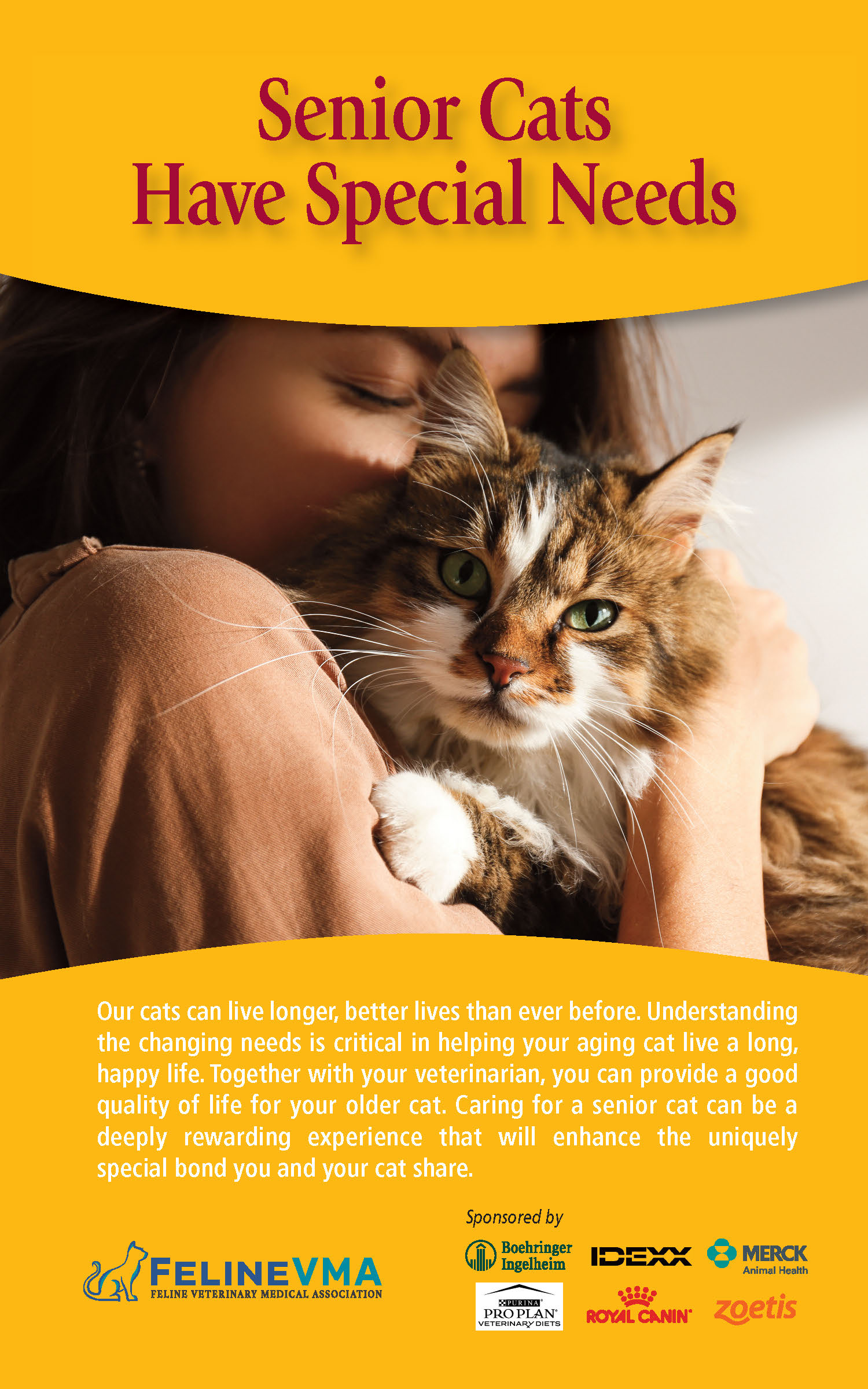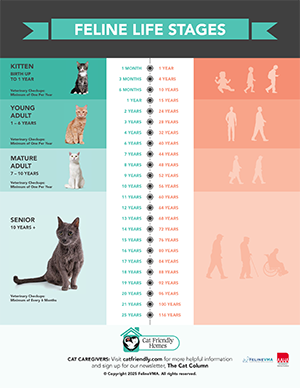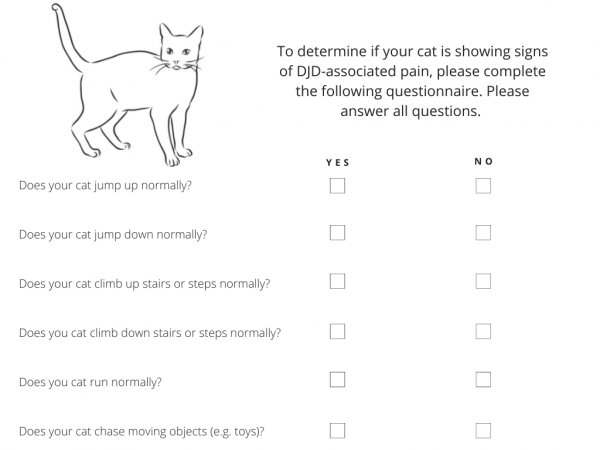What is a Senior Cat?
Cats go through four life stages as they age:
- Kitten
- Young Adult
- Mature Adult
- Senior
Cats are considered senior when they are 11 years old, which is about 60 in human years! Like people, cats’ needs change as they get older. It’s important to understand the physical and emotional changes your cat will go through as they age. Cats age more rapidly than people; the lifespan of a cat is five times shorter than of a human. You and your veterinarian can work together to meet your senior cat’s changing health needs and provide a good quality of life.
Senior Cat Checkups
Cats are masters at hiding signs of pain and disease. Part of being a responsible caregiver includes bringing your cat in for regular veterinary checkups. Senior cats 10 to 15 years old should have checkups a minimum of every 6 months, and cats over 15 years should be seen every 4 months. Cats with ongoing health issues may need more frequent checkups.
As your cat ages, it’s important to be aware of changes that may occur. Discuss these with your veterinarian to determine how to provide the best care for your cat.
Common Age-Related Changes Include:
- Changes in behavior and sleeping patterns
- Increased ‘talking’ or meowing
- Pain-related to movement (jumping, using stairs, in/out of high-sided litter box)
- Changes in sight and hearing
- Decreased sense of smell and taste
- Weight loss and loose skin
- Brittle nails or nails that need to be trimmed more often
- Decreased ability to absorb nutrients and increased need for protein
Is My Senior Cat in Pain?
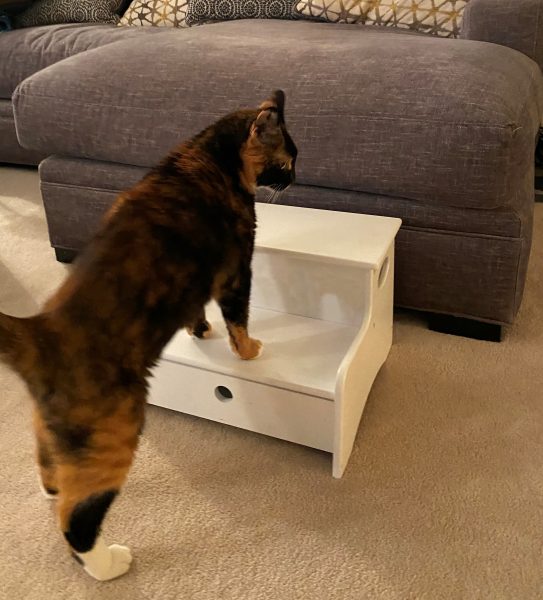
Pain can be hard to notice because cats try to hide signs of discomfort and illness from us. This is another reason it is important to bring your senior cat for regular veterinary checkups. While it may be difficult for you to notice if your senior cat is in pain, your veterinarian is trained to identify subtle clues. Feline arthritis, or degenerative joint disease (DJD), is a common cause of pain in senior cats. Studies show as many as 92% of cats suffer from DJD.
One way you can help identify DJD-associated pain is by observing any changes in your cat’s behavior or normal routine. You can start by filling out the DJD questionnaire below and bringing it with you to your cat’s next veterinary checkup. Your veterinarian will discuss ways to manage pain and provide care recommendations. This could include adding ramps or stairs for easy access to favorite spaces, night lights to see better in the dark, or litter boxes with a lower entry so your cat can get in and out more easily.
Taking videos of your cat jumping and playing throughout the years can be helpful in order to notice small changes over time. Learn more at catfriendly.com/pain.
Nutrition and Weight Management
Keeping your senior cat at a healthy weight is essential. During checkups, your veterinarian will weigh your cat and feel your cat’s muscles. This information helps to determine your cat’s ideal weight and body condition. Slow weight gain or loss is hard to see. You can weigh your cat at home using a scale for lower weight levels (e.g., baby scale), and alert your veterinarian to any weight gain or loss.
Senior cats are at risk of becoming underweight due to a decreasing sense of taste or smell, which can cause a lack of interest in eating. Overweight cats are more likely to develop diabetes, arthritis (DJD), heart disease, and lower urinary tract disease.
If you are having problems getting your cat to eat, have your veterinarian make sure your cat is not sick. If your veterinarian determines your cat is healthy, try offering a different texture of food (e.g., finely ground food instead of chunky), strong smelling food, warmed or chilled canned food, or fresh food that hasn’t sat out too long.
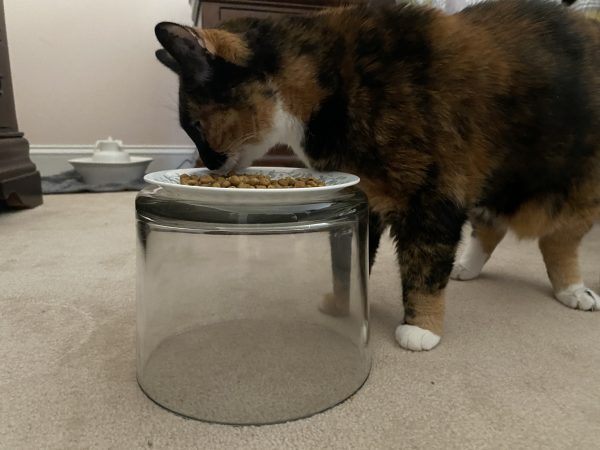
Offer meals a few times throughout the day. Some cats like small amounts of flavoring, such as canned tuna juice or low-sodium, unseasoned broth. Place food where your cat spends the most time and, in a place where your cat can eat quietly and calmly. Senior cats may prefer wide and low-sided food and water bowls that don’t touch their whiskers. Providing elevated bowls can help those that may be in pain from bending down to eat. Hydration is very important for senior cats so consider providing multiple drinking stations, and speak to your veterinarian about foods or supplements that can increase water intake.
Managing Diseases and Conditions
Many illnesses and conditions can occur as your cat ages, and sometimes several at a time. If you see a change in your cat’s behavior and habits, alert your veterinarian. Some common diseases affecting older cats are arthritis (DJD), cancer, chronic kidney disease, diabetes, dental disease, gastrointestinal disease, high blood pressure, thyroid disease, and cognitive dysfunction syndrome (affecting memory and awareness). General signs of disease which may be hard to notice at first can include:
- Drinking more or less, and/or producing larger amounts of urine
- Nausea, vomiting, or constipation
- Decreased appetite, weight loss, or muscle loss
- Poor fur/coat and decreased grooming
- Changes in behavior including hyperactivity (unusual activity), anxiety, tiredness, or not using the litter box; changes to sleeping patterns and resting locations
- Abnormal swelling or skin masses (unusual lumps or growths)
- Sores that do not heal; bleeding or discharge
- Difficulty breathing, urinating, or passing stools
Managing diseases can be stressful for you and your cat. Your veterinarian will discuss a treatment and management plan with you. Discuss your concerns, ideas, and ability to
follow through with recommendations so you and your veterinarian can create a plan that works for you and your cat. Continuing checkups is the best way to monitor your cat’s health, pain, and quality of life status.
Quality of Life and End of Life Decisions
Even with regular veterinary care and treatment, many senior cats will reach a point at which their quality of life is severely affected by illness or pain. When this time comes for your cat, please discuss the best course of action with your veterinarian. Together you will work through a quality-of-life assessment that asks questions to help you determine the next steps. Your veterinarian can support you and your cat during end of life care. They can provide hospice care and teach you ways to help your cat be comfortable during the end stages of an illness. If euthanasia becomes necessary, they will help you understand what to expect during and after the process. Preparing for the experience will not take away the pain and grief, but will help ensure a calmer, more informed process. Read more at catfriendly.com/end-of-life.
We all want to grow old with grace and dignity, and we want the same for our pets. Fortunately, expert understanding of cat health and advances in veterinary medicine means cats can live longer, better lives than ever before. As your cat’s caregiver, there’s much you can do to keep your cat healthy and happy. We have additional tips for caring for your senior cat. Please download our Senior Cats Have Special Needs brochure for more information on senior cat nutrition and weight management, managing diseases, quality of life, and end of life decisions.


